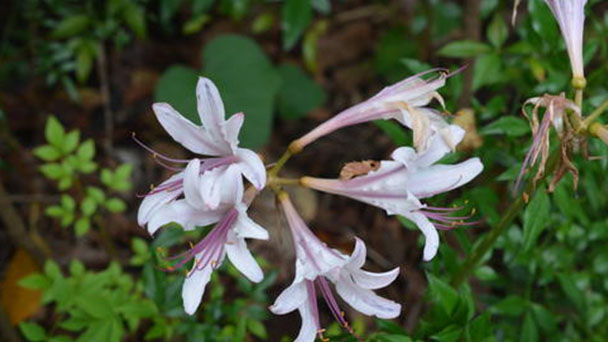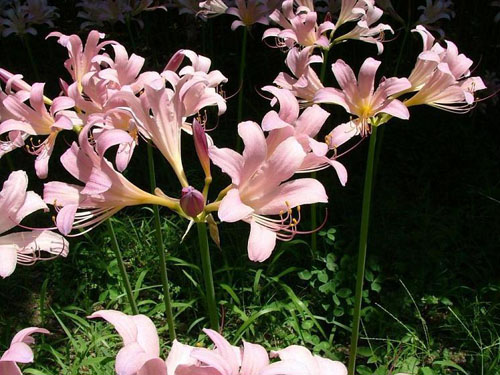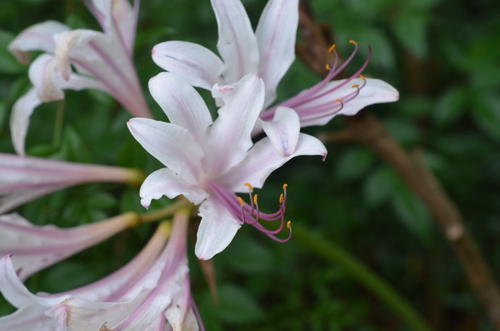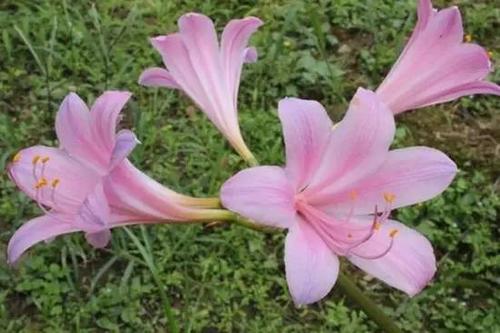Resurrection Lily (Surprise Lily) Profile: Info, Care & Growing Guide
Written by Maggie
Nov 02 2021

Resurrection Lily (scientific name: Lycoris Squamigera Maxim.), also called surprise lily, was named by Maxim in 1959. Perianth lobes are oblateolate, margin base slightly wrinkled. Stamens are subequal to perianth lobes. Style is slightly protruding from perianth.
It mostly grows in the wet places near mountains and streams. resurrection lily is found in China, Japan and Korea.
Resurrection Lily Picture

Resurrection Lily Info
| Botanical Name | Lycoris squamigera |
| Common Names | Resurrection Lily, surprise lily, magic lily, naked lady |
| Plant Type | Flowering plant |
| Sun | Full sun, partial shade |
| Hardiness Zones | 5 to 9 |
| Flower color | White, pink |
| Native Area | Japan, Korea |
| Mature size | 1.5 to 2 ft. tall, 1.5 to 2 ft. wide |
Characteristics of Resurrection Lily
Resurrection Lily Stems
Resurrection Lily is a perennial herb. Bulb is ovate, ca. 5 cm in diam.
Resurrection Lily Leaf
Resurrection Lily (surprise lily) leaves in autumn, about 8 cm long, Withers immediately, and draws again in the early spring of the next year. The leaves are strip-shaped, blunt and round at the top, green, and about 2 cm wide.
Resurrection Lily Flowers
The flower stem of the Resurrection Lily is about 60 cm tall. Resurrection Lily has 2 involucral bracts, lanceolate, ca. 6 cm long, ca. 1.3 cm wide; Umbel is with 4-8 flowers; Flowers are lavender red; Perianth lobes are oblanceolate, ca. 7 cm long and 1.8 cm wide, margin slightly contracted at base, perianth tube ca. 2 cm long; Stamens are subequal to perianth lobes; Style is slightly protruding from perianth.
Resurrection Lily Growth Conditions
Resurrection Lily (surprise lily) likes to grow in sunny and humid environments, such as wet slopes, rocks and rocky cliffs. However, it can also withstand semi-cloudy and arid environments. Resurrection Lily is slightly cold resistant and has strong vitality, without strict requirements on soil.
How to grow and care for Resurrection Lily
Resurrection Lily Light Requirements
Resurrection lilies thrive in areas with full sun. However, the flowers will tolerate partial shade, mainly in hotter climates.
Resurrection Lily Soil Care
Resurrection lilies (surprise lily) are not too precise about their soil, however they develop nicely in a loamy mattress with desirable drainage. If the soil is poor-quality, work a 3-inch-thicken layer of compost into the pinnacle foot of soil.
Resurrection Lily Watering
The Resurrection lilies are now not drought-tolerant, so it desires reasonable watering all through its developing season. However, you must restrict watering at some point of its dormant length all through the wintry weather months, as nicely as at some stage in the duration in late June when the foliage starts to die lower back however the blossoms have not sprung forth yet.
Resurrection Lily Temperature & Humidity
Resurrection lilies may additionally be hardy—in fact, they're the hardiest of all the Lycoris species—but they do not respect severe temperatures. If subjected to intense warmth or cold, its plants will be smaller and fewer. resurrection lilies go through from bloodless harm when the temperature dips beneath 28 tiers Fahrenheit. To shield the plant, unfold a 2-inch-thick layer of mulch on the pinnacle of the bulbs in the winter.
Resurrection Lily Fertilizer
Give Resurrection lilies about a month to settle in earlier than fertilizing, or you hazard burning the roots. In the autumn, feed it with a high-potassium fertilizer, then grant a nitrogen-rich fertilizer in the early spring to motivate growth.

Toxicity of Resurrection Lily
Resurrection lilies (surprise lily) are toxic if consumed, due to the alkaloids, lycorine and galanthamine, that the plant contains. However, the toxicity degree is low.
Signs of poisoning after eat a Resurrection Lily include:
- Abdominal pain
- Nausea, vomiting, and diarrhea
- Salivation
- Shivering
Resurrection Lily Propagation
Under the natural state, Resurrection Lily produces few seeds and has a very low germination rate, so it is generally propagated by asexual propagation.
Resurrection Lily Propagation from Division
The simplest method is to take the way of fractional Resurrection Lily (surprise lily), in the dormant period or after flowering will dig out the plant, the mother ball near the epiphytic sub-ball is taken off planting, about one, two years later can blossom.
Resurrection Lily Propagation from Cutting
Resurrection Lily can be cut to promote the growth of bulblets to improve the reproduction coefficient. It can be cut once every 3-5 years, and the bulblets can be buried in the ground 3-5 cm deep. Cut the bulbs with a sharp knife from the base upward in a cross shape to about 3/4 of the bulb neck. Then bury the bulbs in sand or peat septum to about 3/4 of the depth of the bulb. Many small balls can be produced at the incision and then planted separately with the small balls.
Disease Control of Resurrection Lily
C disease
A common disease is the charcoal blast. Before planting, soak bulbs in 0.3% copper sulfate solution for 30 minutes, wash them with water, dry them and then plant them. Every half a month spray 50% carbendazim wettable powder 500 times liquid control. At the beginning of the disease, spray with 50% benzoite solution 2500 times.
Moth
The larvae mainly harm the leaves, buds and fruits of Resurrection Lily (surprise lily) by chewing on the leaves and chewing on the scapes and seeds. Generally, the larvae do harm from late spring to November. The prevention and treatment can be done with 5% Regent suspension solution of 2500 times and Wanling solution of 1000 times.
Lycoris radiata the moth
The larvae of Lepidophora larva will invade the plants of Resurrection Lily (surprise lily). Usually, the leaves are hollowed out and can directly eat the inside of the bulb. A large number of green or brown feces will be left in the affected areas. The prevention and control can be combined with the winter or early spring to dig out the overwintering insects pupae, reduce the insect population; When it happens, spray the insecticide Lexiborn 1500 times liquid or phoxim 800 times emulsion liquid, choose in the morning or evening when the larvae come out to take food spray, the prevention and control effect is better.
Thrips
Thrips mainly inhale nutrients at the bulbs and leaves of Resurrection Lily (surprise lily), which results in the loss of greenness of the leaves, especially after the fruits are mature. Therefore, spray rotation can be used for control with 25% imidacloprid 3000 times solution and 70% emmerol 6000 ~ 10000 times solution.
Resurrection Lily Distribution
Resurrection Lily (surprise lily) is produced in Shandong, Jiangsu, and Zhejiang provinces. Hebei, Henan is also cultivated.
Resurrection Lily is also found in Japan and North Korea.
Resurrection Lily type specimens were collected from Japan.
Resurrection Lily Uses
Medicinal value
Resurrection Lily bulb is the raw material of galantamine extraction.It can be used as medicine, with anti-inflammatory hemostasis, clearing heat and analgesia, diuresis and detumescence, stomach and milk.
Usually in spring, autumn, wild or cultivated 2-3 years after the bulb, wash dry, or slice dry. When used, for external use, smash the affected area.
Resurrection Lily uses in gardens
Resurrection Lily (surprise lily) can be used as a ground cover flower under the forest, flower border or natural planting among rocks in the garden. Pair well with other tolerant herbs because of their flowering time and foliage. The planting density is 15-20 cm between plants and 40 cm between rows, and 1 row of other evergreen plants is planted between rows.

Latest Updated
- Benefits of Bugleweed - 7 Science-backed Health Benefits
- Bugleweed Dangers & Side Effects - Is It Poisonous?
- How to Plant Evergreen Trees - What You Should Know
- When to Plant Evergreens - Grow Guide for Evergreen Trees
- 12 Wonderful Evergreen Shrubs for Your Garden
- 12 Popular Evergreen Plants with Pictures for Beginners
- When And How To Prune A Lilac Bush Like a Pro
- How to Grow & Care for Lilac Vine (Hardenbergia Violacea)
- Japanese Lilac Tree (Syringa Reticulata) Care & Propagation Guide
- Shumard Oak Pros and Cons - What to Know
Popular Articles
- Winter maintenance of Antirrhinum Majus
- How to Grow Terminalia Mantaly Tree
- How to Grow and Care for Crossostephium Chinense
- How to grow Antirrhinum Majus in spring
- Peristeria Elata (Dove Orchid) Profile: Info & Care Guide
- Underwatered Snake Plant (Sansevieria Trifasciata) - Signs And How To Fix
- How to Care for Brazilian Jasmine Plant (Mandevilla Sanderi)
- How to Grow & Care for Graptopetalum Purple Delight in Summer
- Rosa Chinensis (China Rose): Plant Growing & Care Tips
- How to Care for Baby Sun Rose (Aptenia Cordifolia)